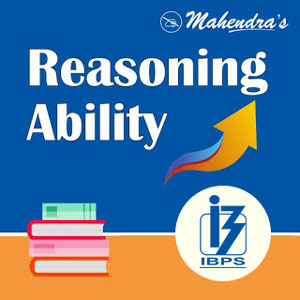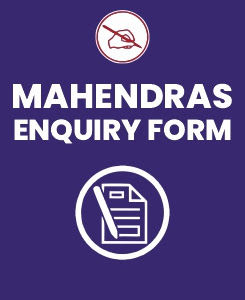Dear Readers,
Mahendras has started special quizzes for IBPS PO & RRB Exam so that you can practice more and more to crack the examination. This IBPS PO & RRB Exam special quiz series will mold your preparations in the right direction and the regular practice of these quizzes will be really very helpful in scoring good marks in the Examination. Here we are providing you the important question of reasoning ability for the IBPS PO & RRB Exam.
Q.1-5. In the following questions, the symbols $, #, @, © and % are used with the following meaning as illustrated below:
‘P $ Q’ means ‘P is not greater than Q’.
‘P # Q’ means 'P is not smaller than Q’.
‘P@Q’ means ‘P is neither smaller than nor equal to Q’.
‘P © Q’ means ‘P is neither greater than nor equal to Q’.
‘P % Q’ means ‘P is neither smaller than nor greater than Q’.
In each of the following questions assuming the given statements to be true, find which of the two conclusions I and II given below them is/are definitely true and give your answer-
निम्न प्रश्नों में कुछ चिन्ह $, #, @, © और % निम्न अर्थ के साथ प्रयोग किये गये हैं जैसा नीचे दिया गया है-
‘P $ Q’ का अर्थ है ‘P, Q से बड़ा नहीं है।'
‘P # Q’ का अर्थ है ‘P, Q से छोटा नहीं है।'
‘P@Q’ का अर्थ है ‘P, Q से न तो छोटा और न ही बराबर है।'
‘P © Q’ का अर्थ है ‘P, Q से न तो बड़ा और न ही बराबर है।'
‘P % Q’ का अर्थ है ‘P, Q से न तो छोटा और न ही बड़ा है।'
निम्नलिखित प्रश्नों में दिये गये प्रत्येक कथन को सत्य मानते हुये, ज्ञात कीजिए कि नीचे दिये गये दो निष्कर्ष I और II में कौन-सा निश्चित रूप से सत्य है और उसी प्रकार से अपना उत्तर दें-
Q-1 Statements: F$G, E@F, J#D, G%I, D#E
Conclusions: I. J@G II. I@D
01. If only conclusion I is true.
02. If only conclusion II is true.
03. If either conclusion I or II is true.
04. If neither conclusion I nor II is true.
05. If both conclusions I and II are true.
कथन: F$G, E@F, J#D, G%I, D#E
निष्कर्ष: I. J@G II. I@D
01. यदि केवल निष्कर्ष I सत्य है।
02. यदि केवल निष्कर्ष II सत्य है।
03. यदि या तो निष्कर्ष I या फिर II सत्य है।
04. यदि न तो निष्कर्ष I और न ही II सत्य है।
05. यदि निष्कर्ष I व II दोनों सत्य हैं।
Q-2 Statements: A©S, X$V, S$R, C$X, R©C
Conclusions: I. C@A II. V#S
01. If only conclusion I is true.
02. If only conclusion II is true.
03. If either conclusion I or II is true.
04. If neither conclusion I nor II is true.
05. If both conclusions I and II are true.
कथन: A©S, X$V, S$R, C$X, R©C
निष्कर्ष: I. C@A II. V#S
01. यदि केवल निष्कर्ष I सत्य है।
02. यदि केवल निष्कर्ष II सत्य है।
03. यदि या तो निष्कर्ष I या फिर II सत्य है।
04. यदि न तो निष्कर्ष I और न ही II सत्य है।
05. यदि निष्कर्ष I व II दोनों सत्य हैं।
Q-3 Statements: D©E, H#G, L@S, E$H, G#L
Conclusions: I. H@L II. S©H
01. If only conclusion I is true.
02. If only conclusion II is true.
03. If either conclusion I or II is true.
04. If neither conclusion I nor II is true.
05. If both conclusions I and II are true.
कथन: D©E, H#G, L@S, E$H, G#L
निष्कर्ष: I. H@L II. S©H
01. यदि केवल निष्कर्ष I सत्य है।
02. यदि केवल निष्कर्ष II सत्य है।
03. यदि या तो निष्कर्ष I या फिर II सत्य है।
04. यदि न तो निष्कर्ष I और न ही II सत्य है।
05. यदि निष्कर्ष I व II दोनों सत्य हैं।
Q-4 Statements: A#L, G#X, L#P, D#G, P©D
Conclusions: I. A#X II. D%X
01. If only conclusion I is true.
02. If only conclusion II is true.
03. If either conclusion I or II is true.
04. If neither conclusion I nor II is true.
05. If both conclusions I and II are true.
कथन: A#L, G#X, L#P, D#G, P©D
निष्कर्ष: I. A#X II. D%X
01. यदि केवल निष्कर्ष I सत्य है।
02. यदि केवल निष्कर्ष II सत्य है।
03. यदि या तो निष्कर्ष I या फिर II सत्य है।
04. यदि न तो निष्कर्ष I और न ही II सत्य है।
05. यदि निष्कर्ष I व II दोनों सत्य हैं।
Q-5 Statements: K#Q, E%L, Q#Z, C$E, Z©C
Conclusions: I. Z©K II. L@Z
01. If only conclusion I is true.
02. If only conclusion II is true.
03. If either conclusion I or II is true.
04. If neither conclusion I nor II is true.
05. If both conclusions I and II are true.
कथन: K#Q, E%L, Q#Z, C$E, Z©C
निष्कर्ष: I. Z©K II. L@Z
01. यदि केवल निष्कर्ष I सत्य है।
02. यदि केवल निष्कर्ष II सत्य है।
03. यदि या तो निष्कर्ष I या फिर II सत्य है।
04. यदि न तो निष्कर्ष I और न ही II सत्य है।
05. यदि निष्कर्ष I व II दोनों सत्य हैं।
Q.6-10. Study the following information carefully and answer the questions given below:
There are eight people P, G, R, K, T, N, V, W sitting around a circular table facing outside the center. They are from different cities - Delhi, Pune, Goa, Punjab, Haryana, UP, Ladakh and Orissa. But not necessarily in the same order.
G, who is not an immediate neighbor of W, sits second to the left of P, who is from Ladakh. The person who is from Goa sits third to the right of the one who is from Haryana. V, who is from Pune sits second to the left of N, who is from Delhi. V sits third to the left of the one who is from Punjab. There are 3 people sit between P and R, who is from Orissa. K is not an immediate neighbor of both P and G, who is from Punjab. T sits opposite to the one who is from Pune.
निम्नलिखित जानकारी का ध्यानपूर्वक अध्ययन करें और नीचे दिए गए प्रश्नों के उत्तर दें:
आठ व्यक्ति P, G, R, K, T, N, V, W हैं जो केंद्र के बाहर की ओर मुख करके एक गोलाकार मेज के चारों ओर बैठे हैं। वे विभिन्न शहरों - दिल्ली, पुणे, गोवा, पंजाब, हरियाणा, यूपी, लद्दाख और उड़ीसा से हैं। लेकिन जरूरी नहीं कि उसी क्रम में हो।
G, जो W का तत्काल पड़ोसी नहीं है, P के बाएं ओर दूसरा है, जो लद्दाख का है। जो व्यक्ति गोवा से है, वह हरियाणा के व्यक्ति के दाएं तीसरा है। V, जो पुणे से है, N के बाएं दूसरे स्थान पर है, जो दिल्ली से है। V उस व्यक्ति के बाएं तीसरे स्थान पर है जो पंजाब से है। P और R जो उड़ीसा से हैं, के बीच 3 लोग बैठे हैं। K, P और G जो पंजाब से है, दोनों का तत्काल पड़ोसी नहीं है। T उसके विपरीत बैठता है जो पुणे से है।
Q-6 Who amongst the following is from UP?
01. P
02. G
03. R
04. W
05. None of these
निम्नलिखित में से कौन यूपी से है?
01. P
02. G
03. R
04. W
05. इनमें से कोई नहीं
Q-7 What is K’s position with respect to N?
01. Third to the right
02. Second to the right
03. Third to the left
04. Second to the left
05. Fourth to the right
N के संबंध में K की स्थिति क्या है?
01. दाएं तीसरा
02. दाएं दूसरा
03. बाएं तीसरा
04. बाएं दूसरा
05. दाएं चौथा
Q-8 How many people are sitting between the one who is from Ladakh and N when counted in clockwise direction from the one who is from Ladakh?
01. One
02. Two
03. Three
04. Four
05. None
वह व्यक्ति जो लद्दाख से है और N के बीच कितने लोग बैठे हैं जब लद्दाख के व्यक्ति के दक्षिणावर्त दिशा में गिना जाए?
01. एक
02. दो
03. तीन
04. चार
05. कोई नहीं
Q-9 Four of the following five pairs are alike in a certain way based on their positions in the above arrangement and so form a group. Which of the following does not belong to the group?
01. G-GOA
02. W-DELHI
03. N-DELHI
04. K-PUNJAB
05. T- PUNE
उपर्युक्त व्यवस्था में उनके स्थिति के आधार पर निम्नलिखित पाँच में से चार जोड़े एक समान हैं और इसलिए एक समूह बनाते हैं। निम्नलिखित में से कौन समूह से संबंधित नहीं है?
01. G- गोवा
02. W- दिल्ली
03. N- दिल्ली
04. K- पंजाब
05. T- पुणे
Q-10 Which one of the following statements is false?
01. K is to the immediate left of the one who is from UP.
02. The one who is from Orissa sits opposite to P.
03. T sits opposite to V.
04. K is to the immediate right of the one who is from UP.
05. None of these
निम्नलिखित में से कौन सा कथन असत्य है?
01. K, उस व्यक्ति के तत्काल बाएं है जो यूपी से है।
02. जो उड़ीसा से है वह P के विपरीत बैठा है।
03. T, V के विपरीत बैठा है।
04. K, उस व्यक्ति के तत्काल दाएं है जो यूपी से है।
05. इनमें से कोई नहीं
EXPLANATION:-
Q.1-5.
Q-1 CA: 4
Q-2 CA: 1
Q-3 CA: 2
Q-4 CA: 4
Q-5 CA: 2
Q.6-10.
Q-6 CA: 4
Q-7 CA: 3
Q-8 CA: 4
Q-9 CA: 3
Q-10 CA: 1






0 comments:
Post a Comment
MAHENDRA GURU